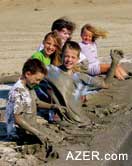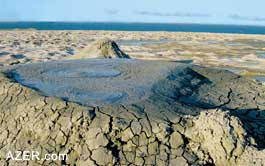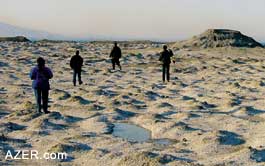|

Summer 2003 (11.2)
Pages
44-49
Mud Volcanoes
Mysterious
Phenomena Fascinate Scientists and Tourists
by Ronnie Gallagher
Volcanoes and volcanic eruptions are words we associate with
enormous release of earth's energy, which results in a change
to the face of the Earth. They usher us back to distant ages
when the Earth was a lifeless planetary body when fire and water
raged.
Everyone today knows about burning volcanoes made of magma with
its liquid or molten rock. Scores of films have documented their
activities, as have hundreds of books, and thousands of scientific
papers. This is only natural since magmatic volcanoes are not
only exotic phenomena, but they also provide a view deep into
the interior of the Earth which is virtually inaccessible to
us by any other method
Below: (Above right) At Cape Alyat on the
Caspian. Example of mud volcanic activity - pools and mudflows.
(Bottom left) Brianna Sinqufield, thoroughly enjoying a day at
the mud volacones. (Photos: Ronnie Gallagher)
"Mud volcanoes," also
known as "sedimentary volcanoes" or "gas - oil
volcanoes," are close cousins to magmatic volcanoes. Just
like magmatic volcanoes, they can erupt powerfully and hurl flames
to great heights (sometimes even several hundred of meters).
They spew out millions of cubic meters of hydrocarbon gases and
tons of mud. Mud volcanoes also exist on the floor of the sea
and can form islands and banks that alter the topography and
shape of the coastline and even trigger earthquakes.
Another feature of mud volcanoes is their direct relationship
to oil and gas fields. Mud volcanoes resemble super-deep exploration
wells in the sense that they are direct indicators of hydrocarbons
at great depths and provide valuable information on the formation
and migration of oil and gas. Both mud volcanoes and hydrocarbon
fields are the result of a single process of oil and gas formation,
which has a characteristic vertical zone with methane gas forming
in younger strata, overlying a zone of intense formation of oil
and fatty gases.
Below: (Left) Scientists study mud volcanoes
to understand the nature of hydrocarbon activity beneath the
earth's surface. There are more mud volcanoes in Azerbaijan than
any other country. (Photo: Litvin)
Right: Mud Gryphon. (Photo: Ronnie Gallagher)
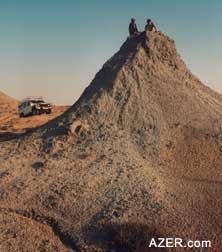 |
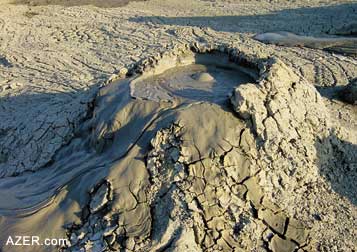 |
Land of fire
Mud volcanoes are one of the visible signs of the presence of
oil and gas reserves hidden deep beneath land and sea in the
Caspian region. Gas seeps are a related phenomenon and occur
when a pocket, filled largely methane gas under the ground, finds
a passage to the surface.
One such famous gas seep is Yanardagh (Fire Mountain) on the
Absheron Peninsula where a continuous fire burns along a hillside.
People often go there to see these dancing flames which never
get extinguished and enjoy a cup of tea at the nearby café.
It's a fascinating phenomenon to watch, especially at dusk. It's
easy to understand how such eternal fires, fueled from the earth
itself, became objects of worship.
The appearance of the Zoroastrians in Azerbaijan almost 2,000
years ago is closely connected with these geological phenomena,
and, according to one theory, the name "Azerbaijan"
itself was derived from the word for "fire" in Persian.
The cult of fire worship was paramount throughout the history
of pre-Islam in this region.
What are Mud Volcanoes?
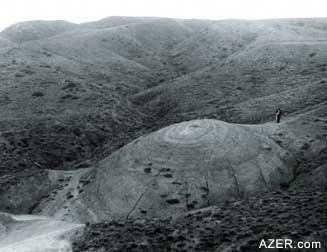 |
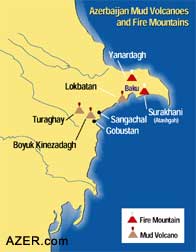 |
Above: A hill created by a mud volcano in Aghjakand
village of Kalbajar region, photo 1936. Kalbajar has been under
Armenian occupation since 1992. (Photo: Azerbaijan National Photo
Archives)
Mud volcanoes are essentially channels for releasing pressurized
gas and mineral water, sometimes with traces of oil, together
with associated mud from great depths (812km) and depositing
them on the surface of the earth where they form mounds ranging
from 5 to 500m high. In both appearance and behavior, they outwardly
resemble a magmatic volcano. The explosive release of pent-up
gases combined with the burning of hydrocarbon gases adds to
this similarity. But, unlike their magmatic cousins, which carry
molten rock or larva or enormous heat to the surface, mud volcanoes
in Azerbaijan are at ambient temperature and may even be cool.
Volcanoes are characterized by a constant activity of domes,
gryphons (cones) and salses (pools). Some are dry in nature;
others, wet. Normally they don't form distinctive volcano shapes
as magmatic volcanoes do. Rather, they just flow down into the
surrounding plains. They often peak at about 1020 m but
can spread across a surface of several kilometers. Among the
largest mud volcanoes in the world are Boyuk Khanizadagh and
Turaghai. Both are located in Azerbaijan.
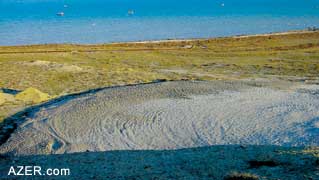  Left: Example
of mud volcanic activity - pools and mudflows. (Photo: Ronnie
Gallagher) Left: Example
of mud volcanic activity - pools and mudflows. (Photo: Ronnie
Gallagher)
Because of the softness of the
rock, mud volcanoes on a geological timescale are considered
to be rather ephemeral. The mud or breccia quickly erodes with
wind and rain into systems of gulleys and ridges fanning out
from the crater margins. Indeed a tell-tale sign of a mud volcano
is its deeply grooved and often very attractive flanks. Mud volcanoes
in the sea, of course, erode quickly with wave action.
Mud volcanoes are often created at points of weakness in the
Earth's crust, along fault lines. They are associated with geologically
young sedimentary deposits and the presence of organic gas from
hydrocarbon deposits. Worldwide there are some 700 known mud
volcanoes. About 300 of them exist in Eastern region of Azerbaijan
and in the Caspian Sea.
While there is some dispute about the origins of mud volcanoes,
geologists generally agree on some of the aspects of the formation
and activities. Eruptions can occur when mud and sand are squeezed
upwards by seismic forces. Here gravitational forces and tidal
action appear to play a role. The sudden release and upward expansion
of dissolved gases may also play a key role.
The total annual volume of gas emitted by all the volcanoes in
Azerbaijan is estimated at 20 million square meters per year
however, the greatest volume of gas is released when major eruptions
occur such as the Turaghayi volcano in 1946. Based upon the height
of its flames and its duration which lasted several hours, an
estimated 500 million cubic meters of gas were released.
Volcanic Frequency
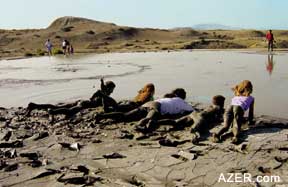  Photo
by Ronnie Gallagher. Photo
by Ronnie Gallagher.
The life of a volcano
extends over a long geological interval and is characterized
by both active and extinct phases.
Dormancy, which occurs between eruptions, may take place every
three or four years as the one at Lokbatan did or up to 80-90
years as with Bozdagh. Some 50 volcanoes have been erupting in
the eastern region of Azerbaijan during the past 200 years since
documents were kept.
The fact that mud volcano eruptions take place outside centers
of population and because they erupt unexpectedly and are relatively
short in duration, it's rare for them to be observed from beginning
to end. An exception however was Lokbatan.
The Institute of Geology of the Azerbaijan Academy of Science
has studied mud volcanoes and has discovered that the one at
Lokbatan has erupted the most often - 20 times since its history
has been recorded. Lokbatan means 'place where the camel got
stuck'. It may well have been named after the twin humps at the
crest of the hill, which give it a camel-like shape. Lokbatan
is located 15 kilometers south of Baku. This mud volcano erupted
in 1977 and again, even more spectacularly on October 10, 2001.
Here are some of the eyewitness account as reported by BBC [Clare
Doyle].
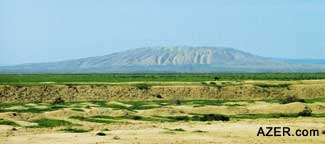  Left: Kinezdagh Mud Volcano - one of the
largest mud volcanos in Azerbaijan. (Photo:
Ronnie Gallagher) Left: Kinezdagh Mud Volcano - one of the
largest mud volcanos in Azerbaijan. (Photo:
Ronnie Gallagher)
"There was a huge
explosion, and a huge flame started coming from the hillside,"
said one witness. "It looked as though an animal was trying
to emerge from the ground."
"The flame was unbelievably large - about 300 meters high.
It was surrounded by dense, black smoke, and lots of mud was
being thrown into the air."
"The largest flames burned for about five minutes. Then
there was another huge explosion, and then the flames settled
down to about 10 or 20 metres (32 or 65 feet) high."
The flames could easily be seen 15 kilometers away on the day
of the explosion, and three days later the volcano was still
burning, although at a much diminished rate.
In Spring 2001, volcanic activity in the Caspian Sea near the
coast resulted in the formation of a new island which has since
washed away by the perpetual pounding of waves against it.
The size of eruptions and their impact varies considerably and
plays an important role in volcano formation. The length of the
individual mud flows such as those at Otmanbozdagh reached 3km
and averaged 100 to 200m in width. Various estimates of the size
of eruptions have been made. For example, Y. Shegren calculated
that the eruption at Lokbatan in 1897 dumped approximately 200,000
cubic meters of mud material on the surface of the earth. Similarly,
the Turaghayi volcano emitted some 50,000 m3 of breccia in 1947.
If such a quantity of mud is typical of an average eruption,
then the formation of the sizeable mountain at Turaghayi would
have been required approximately 6,000 eruptions.
Are Mud Volcanoes
Safe?
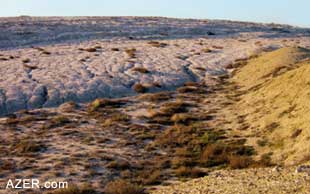  Left: Example
of mud volcanic activity - pools and mudflows. (Photo: Ronnie
Gallagher) Left: Example
of mud volcanic activity - pools and mudflows. (Photo: Ronnie
Gallagher)
Fortunately mud volcanoes
occur away from populated centers and don't usually result in
disastrous consequences. However, cases have been known where
they have caused serious damage and loss of life.
According to local residents, a volcanic eruption which took
place in Bozdagh about 88 km northeast of Shamakhi resulted in
the deaths of six shepherds who happened to be camping overnight
in its crater. About 2,000 sheep in their flock were also killed.
There are legends surrounding the destruction of an entire settlement
known as 'Old Gliady' from an eruption that took place in the
15th century.
An eruption on the island of Sangi-Mughan (Svinoi) in 1932 and
the subsequent fireball that enveloped the entire island killed
the lighthouse keeper, his family and some other local inhabitants.
Fortunately, such events are extremely rare, but the message
is clear: Don't build too close to mud volcanoes. Such advice
would have been well heeded by those who built too close to the
edge of the Baku reservoir of Jeyranbatan which was destroyed
by a mud flow in 2002.
It should be noted that Lokbatan is also an oil reservoir and
the vicinity supports many State Oil Company of Azerbaijan Republic
(SOCAR) oil derricks which have been producing oil for more than
50 years. While the intermittent eruptions don't seem to affect
oil productivity, explosions and clastic missiles do pose an
ongoing threat to surface facilities and equipment. The gas condensate
platform for Shah Deniz, one of BP's project, is located adjacent
to an extinct subsea mud volcano. Geological studies have indicated
that its proximity should not pose any significant risk.
Geologists describe mud volcanoes as capricious, and are still
arguing about exactly how they are formed. Some believe they
are created during the sedimentary process itself, while others
argue that there are other influences at play as well, including
seismic activity.
To the non-geologist, the explanations can seem, well, as "clear
as mud". The arguments about their origins only add to the
aura of mystery that surrounds these unusual and enigmatic phenomena.
Tourist itinerary
Azerbaijan's mud volcanoes definitely should be part of any tourist's
itinerary. So many of them are within close proximity to Baku,
especially those at Alyat, Gobustan and other locations. Mud
volcanoes come in a variety of shapes and sizes, but those most
common in Azerbaijan have several small cones, or vents. These
small cones are an amazing and even beautiful sight. They emit
cold mud, water and gas. They are often characterized by rude
gurgling noises to the delight of children. On hot summer days,
the gryphons and salses provide them with hours of entertainment.
(Suggestion: take plenty of clean clothes, plastic bags for muddy
clothes, and your own supply of water to wash off afterwards.)
Chemically, volcanic mud is composed primarily of silica (5570
percent). In addition, the mud has been found to contain quantities
of curative properties (iodine, bromine, calcium, magnesium,
organic acids and aromatic hydrocarbons - to name just a few).
As the mud solution has no significant toxic substances, it has
been recommended as a curative agent for mud baths and use at
spas. Just as in the Russian towns of Feodosia and Kerch, there
is potential for Azerbaijan to develop its own spas from this
volcanic mud.
With the limited number of tourists that visit Azerbaijan today,
the volcanoes are not under any serious threat. However, with
their distinctive 'lunar' landscape, scientific interest, tourist
and spa potential, there is the possibility that one day too
many tourists could lead to inevitable degradation and damage.
Mud volcanos are themselves unique monuments and need to be protected
for future posterity. The process has already begun as 23 mud
volcanoes were designated for protection last year.
Sources:
Azerbaijan Academy of Sciences Geology Institute: Ibrahim S.
Guliyev, Akbar A. Feyzullayev: "All About Mud Volcanoes".
Adil Aliyev: Presentation about Mud Volcanoes to the recently-formed
Natural History Association of Azerbaijan, 2003.
To learn more about mud volcanoes in Azerbaijan or about joining
the new Natural History Association, feel free to contact the
author Ronnie Gallagher at Gallagher_ronnie@yahoo.co.uk.
You may also contact Abbas Islamzov who resides in Baku at abbasislam@msn.com.
Back to Index
AI 11.2 (Summer 2003)
AI Home
| Search | Magazine
Choice
| Topics
| AI Store | Contact us
Other Web sites
created by Azerbaijan International
AZgallery.org | AZERI.org | HAJIBEYOV.com
|


